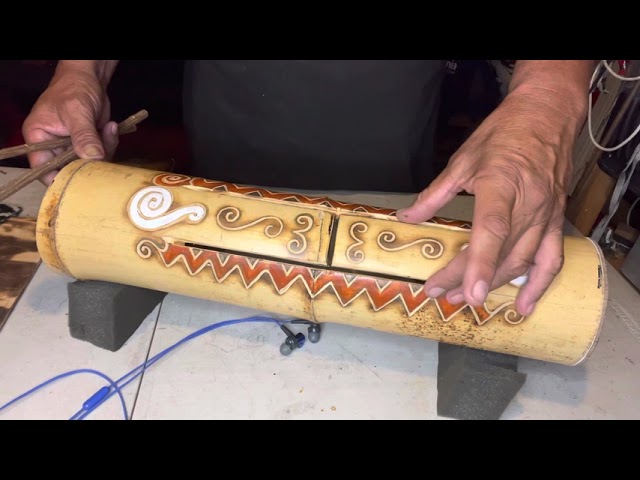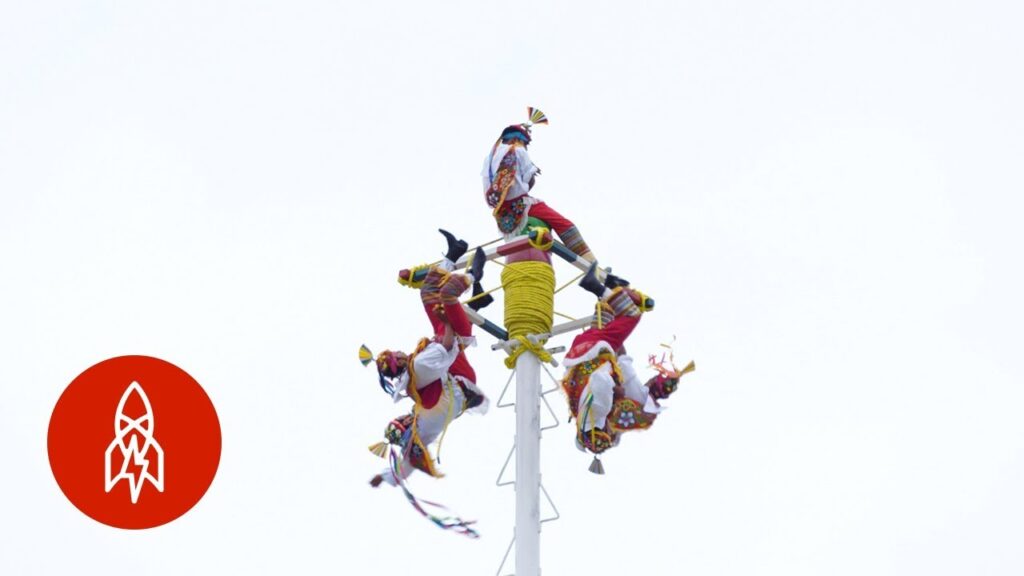The Enigmatic Teponaztli Drum: An Introduction
The teponaztli is not just a musical instrument; it’s a storied artifact deeply embedded in the cultural fabric of Mexico. Often referred to as a «split drum,» it is classically crafted from hollowed-out hardwood logs, ranging from the lush forests of the Mexican landscape. Its dual tongues, carved on the drum’s surface, produce distinct pitches when struck, a characteristic that makes this percussion instrument unique amongst its musical peers.
The teponaztli was fundamental in various ceremonies and rituals of pre-Columbian societies, underscoring the link between music and the divine. The drum’s beat served as a method to communicate with deities, summon rain, and even narrate historical events through its rhythmic storytelling. The significance of the teponaztli’s sounds transcends mere entertainment, offering an audible glimpse into the spiritual life of ancient civilizations.
In the hands of skillful artisans, the teponaztli became a piece of visual art as well. The drum’s exterior is often adorned with intricate carvings and motifs, ranging from simple geometric patterns to elaborate depictions of gods, animals, and other mythological subjects. These designs not only contribute to the drum’s aesthetic appeal but also hint at its ceremonial importance and the messages embedded in its very structure.
Today, the teponaztli continues to captivate those interested in traditional Mexican music. Ethnomusicologists and musicians alike delve into the study and performance of this ancient instrument, exploring its construction, playing techniques, and place in modern compositions. Despite the passage of centuries, the melodic voice of the teponaztli endures, echoing the rich cultural heritage of Mexico and inviting both natives and visitors to experience a resonant piece of history.
Understanding the Cultural Significance of Teponaztli in Mexico
The teponaztli, an ancient Mesoamerican instrument, remains a symbol of Mexico’s rich cultural tapestry. Crafted from hollowed-out hardwood logs and adorned with intricate carvings, the teponaztli is played by striking its surface with rubber-tipped drumsticks, producing a velvety, resonant sound. It served not only as a musical instrument but also as a medium for communication and ritual, liaising between the earthly and the divine.
In pre-Hispanic times, the teponaztli was central to various ceremonies, used to honour gods, mark festive occasions, and command the attention of a crowd. Its sound was thought to echo the heartbeat of Mother Earth, linking the physical act of playing to a deeper, spiritual experience. This association with the earth and spirituality underscores the instrument’s matriarchal symbolism in the context of Mexico’s indigenous cultures.
As a tool for storytelling, the teponaztli carried the narratives of a community, passing down legends and histories through rhythm and melody. Musicians, often revered figures within their communities, held the responsibility of maintaining these oral traditions, thereby ensuring the continuity of cultural identity. The instrument’s role in education and cultural preservation was, and continues to be, indispensable.
Today, while less prevalent in everyday life, the teponaztli endures as a poignant relic and a celebrated emblem in cultural festivals and academic research. It inspires not only a sense of nostalgia for a bygone era but also a recognition of the resilience of Mexican culture in the face of historical adversities. Efforts to revive traditional music have led to a resurgence of the teponaztli’s use, reminding us of its powerful place in Mexico’s cultural narrative.
The Craftsmanship Behind a Teponaztli
The teponaztli is an integral part of Mexico’s rich cultural tapestry, woven into the history and traditions of its indigenous peoples. This fascinating percussion instrument is not just a means to produce rhythmic sounds; it is a testament to the skill and creativity of the craftsmen who build it. The teponaztli, often made from hollowed-out hardwood, boasts intricate carvings and designs that reflect the artisan’s dedication to their craft and heritage.
Carving a teponaztli requires an understanding of the wood’s properties and a steady hand to master the fine art of shaping and detailing. The craft begins with the selection of the perfect log, traditionally from trees like the tzompantle, and progresses through a meticulous process of hollowing, carving, and tuning. Each step is purposeful, transforming a piece of wood into a melodious artifact that carries not just sound, but also the story of its creation.
Traditional motifs often adorn a teponaztli, ranging from geometric patterns to representations of gods and myths from pre-Hispanic times. These designs are more than decoration; they serve as a bridge to the past, connecting those who hear its sound to the beliefs and ceremonies of the old Mesoamerican civilizations. The craftsmanship behind these images requires immense precision, as the artisans use tools handed down through generations.
The method of tuning a teponaztli is a skill in and of itself. The craftsman must strike a balance between the two pitches produced by the instrument. These pitches, created by hitting the slits carved into the top of the drum, must harmonize. The tuner hones the sound by carefully shaving away the inner wood, using only their ear and experience as guides to achieve the perfect tone.
The role of the teponaztli in community and spiritual events underscores its significance. As a result, the craftsmen who are versed in the art of making these instruments are not just skilled workers but also guardians of a cultural legacy. Through their hands, the tale of the teponaztli resonates, a story set to the beat of Mexico’s heart and an homage to the mastery of its artisans.
Teponaztli in Mexican Ceremonies and Rituals
The teponaztli, a traditional Mexican slit drum, has long held a significant role in the rich tapestry of Mexico’s cultural ceremonies and rituals. Crafted from hollowed-out logs, these ancient instruments are emblematic of Mexico’s indigenous heritage and continue to reverberate through the heart of Mexican traditions to this day.
Historically, the teponaztli was integral to Aztec ceremonies, where it was played to honor the gods and mark important communal events. Its rhythmic beats were believed to bridge the terrestrial and the divine, creating a sonic link between the earth and the heavens. This sacred function underscores the cultural importance of music and rhythm in Mexican spirituality.
In contemporary Mexico, the teponaztli still finds its place in ceremonies and rituals, especially those that aim to resurrect or preserve indigenous customs. During the Day of the Dead festivities, for example, the echoing sound of the teponaztli accompanies the vibrant processions and offerings, enhancing the atmosphere of remembrance and celebration of ancestors.
Furthermore, the instrument plays a pivotal role in traditional Mexican dances and performances. Dancers often move to the compelling beat of the teponaztli, which helps to narrate storied histories and folktales through choreographed movements. The drum’s pulsating rhythm is not just heard but also felt, inviting participants and spectators alike into a shared cultural experience.
The intricate carvings found on many teponaztlis are a testament to the artistic skills of its makers and a reflection of the themes and symbols prevalent in Mexican mythology. From depictions of revered deities to the complex cosmologies of pre-Columbian societies, the teponaztli serves as a canvas for expressing Mexico’s ancestral narratives.
Preserving the Legacy: Teponaztli in Modern Times
The teponaztli, a traditional Mexican percussion instrument, has transcended time, continuing to play a significant role in the cultural fabric of modern Mexican society. This slit drum, once integral to pre-Hispanic ceremonies, has been given new life in contemporary music scenes. Musicians and cultural practitioners work diligently to ensure that the unique sounds of the teponaztli not only remind us of the past but also resonate with the present and future generations.
In an era where globalization often overshadows local traditions, the teponaztli stands out as a beacon of cultural heritage. Workshops and education programs across Mexico have taken the initiative to teach young people the art of crafting and playing the teponaztli. The instrument’s intricate designs, often adorned with carvings of Aztec gods and symbols, are also being preserved, showing its dual role as both a musical instrument and a piece of artistic expression.
The use of the teponaztli in contemporary music has seen a remarkable fusion of sounds. It’s not uncommon to hear its distinctive tones in genres ranging from folk to electronica. Through festivals and performances dedicated to indigenous music and instruments, the teponaztli has found a new audience, echoing the ancestral sounds of Mesoamerica through the mountains and valleys of modern Mexico.



